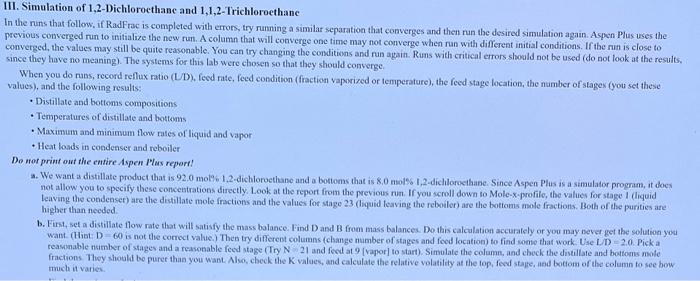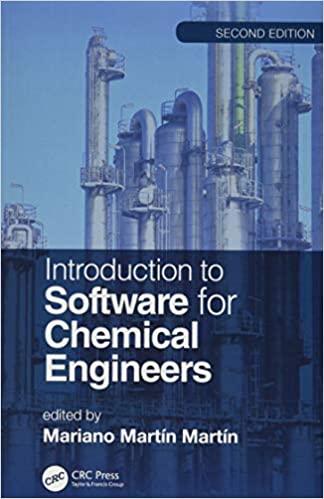help on A-B please fill out this chart for part b data. Use Aspen Plus & show screenshots of work on Aspen plus. The chart needed to be filled out is provided below

III. Simulation of 1,2-Dichlorocthane and 1,1,2-Trichloroethane In the nuns that follow, if RadFrac is completed with errobs, try ruming a similar separation that converges and then nun the desired simulation again. Aspen Plus uses the perious converged run to initialize the new run. A column that will converge one time may not converge when run with different initial conditions. If the nin is close to converged, the values may still be quite reasonable. You can try changing the conditions and run again. Runs with critical errors should not be used (do not look at the results. since they have no meaning). The systems for this lab were chosen so that they should converge. When you do nuns, record reflux ratio (UD), feed nate, feed condition (fraction vaporized of temperature), the feed stage location, the number of stager (you set these values), and the following results: - Distillate and bottoms compositions - Temperatures of distillate and bottoms - Maximum and minimum flow nates of liquid and vapor - Hest loads in condenser and reboiler Do not print out the emtire Aspen Plus report! a. We want a distillate product that is 92.0 mol8 1,2-dichlorocthane and a botioms that is 8.0 mols 1,2-dichlorecthane. Since A spen Plus is a simulator program, it does not allow you to specify these concestrations directly. Look at the report from the pecvious nun. If you scroll down to Mole-x.profile, the values for stage I (liquid leaving the condenser) are the distillate mole fractions and the values for stage 23 (thquid leaving the reboiler) are the bottoms mole fractions. Both of the purities are higher than needed. b. First, set a distillate flow rate that will satisfy the mass bolance. Find D and B from mass balances. Do this calculation accurately or you may never get the solution you wast (Hiat D=60 is not the correct value.) Then try different columns (change number of stages and foed location) to find wome that work. Use LD 2.0. Picka reasinable number of stages and a reasonable feed stage (Try N 21 and feed at 9 (rapor] to start). Simulate the column, and check the divtillate and bottoms mole fractions They should be purer than you want. Also, check the K values, and calculate the relative volatility at the fop, feed stage, and botom of the column to see bow much it varies. III. Simulation - you don't have to give all of the digits Aspen produces III.b. Distillate and bottoms flowrates: Relative volatility at the top Middle Bottom III. Simulation of 1,2-Dichlorocthane and 1,1,2-Trichlorocthane In the runs that follow, if RadFrac is completed with errors, try running a similar separation that converges and then run the desired simulation again. Aspen Plus uses the previous converged run to initialize the new run. A column that will converge one time may sot converge when run with different iaitial conditions. If the run is close to converged, the values may still be quite reasonable. You can try changing the conditions and run again. Runs with critical errors should not be used (do not look at the results, since they have no meaning). The systems for this lab were chosen so that they should converge. When you do runs, record reflux ratio (LD). feed rate. foed condition (fraction vaporized or temperature), the feed stage location, the number of stages fyou set these values), and the following results: - Distillate and bottoms compositions - Temperatures of distillate and bottoms - Maximum and minimum flow rues of liguid and vapor - Heat loads in condenser and reboiler De not print out the entire dspen Plus repart? a. We want a distillate product that is 92.0mol%,1,2-dichloroethane and a bottoms that is 8.0mol%1,2-dichlorocthane. Since Aspen Plus is a simulator program, it does no4 allow you to specify these concentrations directly. Look at the report from the previous run. If you scroll down to Mole-x-profile, the values for stago 1 ( liquid leaving the condenser) are the distillate mole fractions and the values for stage 23 (liquid leaving the reboiler) are the bottoms mole fractions. Broth of the purities are higher than needed. b. First, set a distillate flow rate that will satisty the mass balance. Find D and B from mass balances. Do this calculation accurately or you may never get the solution you Want, (Hint: D60 is not the correct value.) Then try different columns (change number of stages and feed location) to find some that work. Use UD - 2.0. Pick a reasonable namber of stages and a reasonable feed stage (Try N=21 and feed at 9 [vapor] to start). Simulate the column, and check the distillate and bottoms mole fractions. They should be purer than you want. Also, check the K values, and calculate the relative volatility at the top, feed stage, and bottom of the column to see how much it varies











